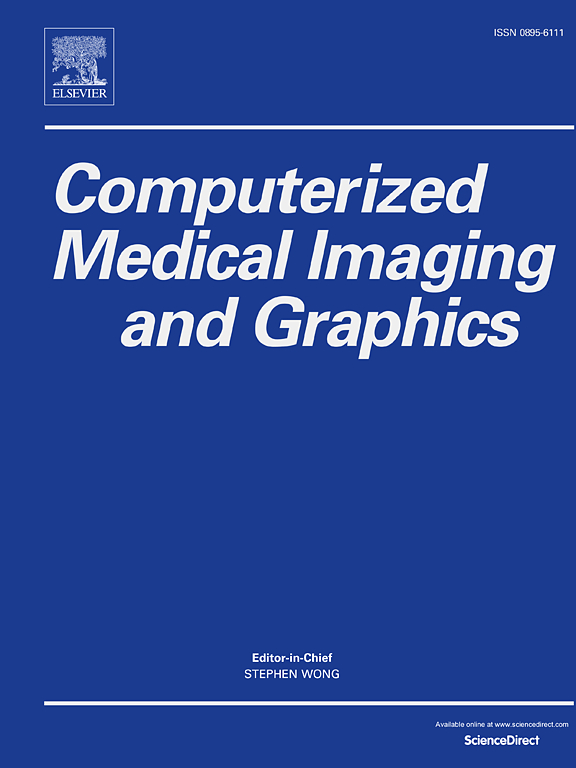检测甲状腺结节和周围组织,并利用超声视频中的运动先验追踪结节。
IF 5.4
2区 医学
Q1 ENGINEERING, BIOMEDICAL
Computerized Medical Imaging and Graphics
Pub Date : 2024-10-01
DOI:10.1016/j.compmedimag.2024.102439
引用次数: 0
摘要
超声波检查在甲状腺结节的临床诊断中起着至关重要的作用。虽然深度学习技术已被应用于甲状腺结节检查,但现有方法都忽略了结节在视频中沿直线运动的先验知识。我们提出了一种新的检测模型--DiffusionVID-Line,并设计了一种新的跟踪算法--ByteTrack-Line,这两种方法都充分利用了甲状腺超声视频中结节直线运动的先验知识。其中,ByteTrack-Line 对检测到的结节进行分组,进一步减轻了医生的工作量,显著提高了诊断速度和准确性。在 DiffusionVID-Line 中,我们提出了两个新模块:Freq-FPN 和 Attn-Line。Freq-FPN 模块用于提取频率特性,利用这些特性降低超声视频中图像模糊的影响。Attn-Line 模块基于医生分段扫描的标准做法,加强了对沿直线运动目标的关注,从而提高了检测的准确性。在 ByteTrack-Line 中,考虑到结节直线运动的特点,我们提出了 Match-Line 关联模块,减少了结节 ID 的切换次数。在检测和跟踪数据集测试中,DiffusionVID-Line 的多组织平均精度 (mAP50) 为 74.2,结节平均精度 (mAP50) 为 85.6,而 ByteTrack-Line 的多目标跟踪精度 (MOTA) 为 83.4。结节检测和跟踪都达到了最先进的性能。本文章由计算机程序翻译,如有差异,请以英文原文为准。
Detecting thyroid nodules along with surrounding tissues and tracking nodules using motion prior in ultrasound videos
Ultrasound examination plays a crucial role in the clinical diagnosis of thyroid nodules. Although deep learning technology has been applied to thyroid nodule examinations, the existing methods all overlook the prior knowledge of nodules moving along a straight line in the video. We propose a new detection model, DiffusionVID-Line, and design a novel tracking algorithm, ByteTrack-Line, both of which fully leverage the prior knowledge of linear motion of nodules in thyroid ultrasound videos. Among them, ByteTrack-Line groups detected nodules, further reducing the workload of doctors and significantly improving their diagnostic speed and accuracy. In DiffusionVID-Line, we propose two new modules: Freq-FPN and Attn-Line. Freq-FPN module is used to extract frequency features, taking advantage of these features to reduce the impact of image blur in ultrasound videos. Based on the standard practice of segmented scanning by doctors, Attn-Line module enhances the attention on targets moving along a straight line, thus improving the accuracy of detection. In ByteTrack-Line, considering the characteristic of linear motion of nodules, we propose the Match-Line association module, which reduces the number of nodule ID switches. In the testing of the detection and tracking datasets, DiffusionVID-Line achieved a mean Average Precision (mAP50) of 74.2 for multiple tissues and 85.6 for nodules, while ByteTrack-Line achieved a Multiple Object Tracking Accuracy (MOTA) of 83.4. Both nodule detection and tracking have achieved state-of-the-art performance.
求助全文
通过发布文献求助,成功后即可免费获取论文全文。
去求助
来源期刊
CiteScore
10.70
自引率
3.50%
发文量
71
审稿时长
26 days
期刊介绍:
The purpose of the journal Computerized Medical Imaging and Graphics is to act as a source for the exchange of research results concerning algorithmic advances, development, and application of digital imaging in disease detection, diagnosis, intervention, prevention, precision medicine, and population health. Included in the journal will be articles on novel computerized imaging or visualization techniques, including artificial intelligence and machine learning, augmented reality for surgical planning and guidance, big biomedical data visualization, computer-aided diagnosis, computerized-robotic surgery, image-guided therapy, imaging scanning and reconstruction, mobile and tele-imaging, radiomics, and imaging integration and modeling with other information relevant to digital health. The types of biomedical imaging include: magnetic resonance, computed tomography, ultrasound, nuclear medicine, X-ray, microwave, optical and multi-photon microscopy, video and sensory imaging, and the convergence of biomedical images with other non-imaging datasets.

 求助内容:
求助内容: 应助结果提醒方式:
应助结果提醒方式:


